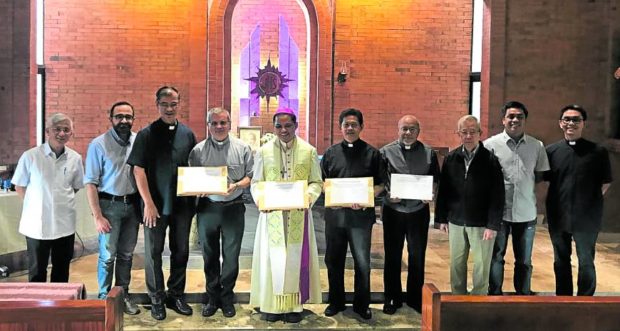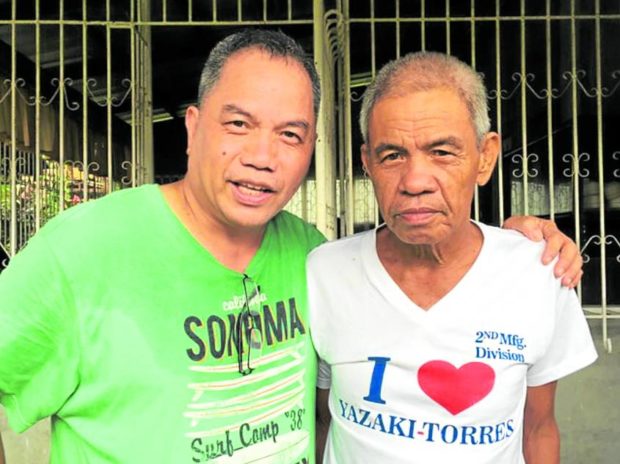Story of healing in PH cited in Salesian’s path to sainthood

INQUIRY | A diocesan tribunal, led by Archbishop Gilbert Garcera of Lipa, Batangas, was convened in 2017 to examine the case of Renato Narvaez whose surprising recovery from coma was attributed to the intercession of Blessed Artémide Zatti. The panel included three medical doctors. (Photo from BRO. OBET NARVAEZ)
In the consistory held on Aug. 27 this year, Pope Francis announced that Blessed Artémide Zatti would be canonized today, Oct. 9, together with another candidate for sainthood.
For somebody to become a saint, a miracle, an event that cannot be explained by logic or natural causes, is one of the requirements. One miracle must be demonstrated to have occurred as a result of the influence of the candidate for sainthood in order for him to be referred to as “blessed.”
The procedure takes off through prayers to the saint who “intercedes” with God, typically to heal a disease. This is then examined by a medical panel that has been sworn to secrecy.
The miracle that paved the way for the canonization of Blessed Zatti, an Italian pharmacist and a noted member of the Salesian order, took place in 2016 at Barangay San Vicente, Santo Tomas City, in Batangas province.
On Aug. 11, then 64-year-old Renato Narvaez felt sick. He tried to rest, hoping that the discomfort would subside, but later started vomiting. His family persuaded him to be brought to the hospital.
Article continues after this advertisementBy the time Renato was admitted to Daniel Mercado Medical Center in Tanauan City, his blood pressure shot up to 240/150. He was found to be having a hemorrhagic stroke and was subjected to various tests. His speech was still normal, but his family noticed that he had lost some of his memory. When he was asked, for example, who his eldest son was, he said it was Glenn, instead of Allan.
Article continues after this advertisement
INTERCESSION | A portrait of Blessed Zatti is enshrined at a community chapel in Rome where Salesian Bro. Obet Narvaez prayed for a miracle on behalf of his stricken brother. (Photo from BRO. OBET NARVAEZ)
Decision-makers
He suffered another stroke two days into his confinement. Dr. Lea de las Llagas, his physician, ordered a second CT (computerized tomography) scan, which showed that Renato’s brain was swollen and had a blood clot. He was brought to the intensive care unit (ICU) and put in induced coma.
Renato’s family and relatives met with the team of doctors, who advised them that he needed to undergo surgery. But Dr. Asis Encarnacion, his attending surgeon, failed to mention what the chances of survival and recovery were after the operation.
Considering the possible expense, about half a million pesos, and the estimated period of recovery at the ICU taking 15 to 20 days, the family could not agree right away on that procedure, which also had no guarantee of a complete recovery.
The main decision-makers in this crisis were Renato’s wife, Gloria; their children (including daughter-in-law Marivel); and Renato’s siblings.
Marivel and Pia, a daughter of Renato, separately called their uncle in Italy, Obet Narvaez, a brother of Renato and a Don Bosco Salesian known as Brother Obet. They informed him about Renato’s situation as they sought his opinion.
Brother Obet agreed with them that Renato should not be operated. The family was already losing hope after the experience of three family members who had also died of a stroke more than a decade ago. Brother Obet recalled that as he was tasked with removing the medical tubes from the bodies of those family members, he would again do so, this time for his brother. They decided that Renato would be discharged and would spend his remaining days at home with his family.
Mustering some strength for himself and with the resolve to help prepare his brother for a happy death, Brother Obet decided to return to the Philippines. He brought his barong, anticipating his brother’s burial, but still clung to his faith. He asked Marivel to pray to Blessed Zatti and told the family he would explain who Zatti was upon his return. He also asked his niece Cristina to put a stampita (holy picture) of Blessed Zatti on the back of Renato’s hand.
Upon his arrival, Brother Obet went straight to the hospital, and signed a waiver on behalf of his brother’s family for Renato’s discharge. Only two tubes remained attached to him, the nasogastric tube (NGT) and the oxygen. The medicines were set aside. This decision was contrary to the advice of their doctors.
With no improvement in Renato’s health, his family and relatives prepared themselves for his approaching end. One of his sons had already bought a memorial lot. Then they started cleaning their house. The front door space was made wider to fit Renato’s would-be casket in preparation for the wake in their home.

TESTIMONY Bro. Obet Narvaez, SDB (left), and his brother Renato who is now in good health after surviving two strokes (Photo from BRO. OBET NARVAEZ)
Waking up
At 8 p.m. on Aug. 21, Renato was brought home, with an NGT and an oxygen tube plugged to his nose. A priest arrived two hours later to administer the Anointing of the Sick. At 11 p.m., he was mumbling some words. The family members and relatives gathered were all crying. Brother Obet led everyone to recite the prayers to commend his dying brother to a peaceful death, invoking the assistance of Blessed Zatti.
But early the next morning at around 4 a.m., Renato woke up, sat on his bed, and removed the tubes from his nose.
He asked his brother to get him balut (fertilized duck egg), but Brother Obet said no and instead offered him hot soup, even as he was amazed to see his brother talking as if he did not wake up from a coma.
Renato wanted to go to the bathroom and was assisted by his wife. After a moment, he stepped out, walking by himself. His family continued to observe him, amazed at what had happened, as he continued to gain strength in the days ahead. Soon enough he was venturing out of his home as if nothing had happened.
Reporting a miracle
Brother Obet recalled that he started praying to Blessed Zatti within a year before Renato’s illness. On Nov. 12, 2015, the eve of Blessed Zatti’s feast day, he looked at Zatti’s portrait in the Catacombs of San Callisto Salesian Community Chapel in Rome, where Brother Obet served as sacristan, and challenged the Blessed to perform a miracle so he could be canonized.
Many sick people, not only in Italy but around the world, await a miracle from Blessed Zatti. Before returning to Rome, Renato’s neighbors insisted to Brother Obet that what happened to his brother was nothing less than a miracle which needed to be reported to the Church. Brother Obet remembered his challenge to Blessed Zatti, and it dawned on him that this experience must have been the miracle he was praying for.
Eventually he relayed this episode to Fr. Francesco Cereda, former vicar of the Rector Major of the Salesians, who was doing his canonical visitation, and to Fr. Pierluigi Cameroni, who, as postulator general of the Salesians, attended to the beatifications and canonizations promoted by the Congregation.
By 2017, the Diocesan Inquiry in Batangas was convened by these members of the Diocesan Tribunal: His Excellency Gilbert Garcera, archbishop of Lipa; Mons. Ruben Dimaculangan, episcopal delegate; Fr. Martin Macasaet SDB, (notary); Fr. Virgilio Hernandez (member of the tribunal for the inquiry), Fr. Jayson Alcatraz, chancellor of the Diocese of Lipa; and doctors Ma. Cecille Cruz, Claver Ramos and Mark Anthony Sandoval as medical experts.
All documentation collected was therefore transmitted to Rome, after which the position or formal brief was prepared.
In an interview, Fr. Cameroni said a “medical council” acknowledged last year that Renato’s healing was rapid, complete and lasting, as well as unexplainable according to the laws of science.
As regards to the question of whether it was a true miracle performed by God, the theological consultors first, then the cardinal fathers and bishops answered in the affirmative.
On April 9 this year, Pope Francis, through His Eminence Cardinal Marcello Semeraro, prefect of the Vatican Congregation for the Causes of Saints, promulgated a decree concerning the miracle attributed to the intercession of Blessed Zatti.
Brother Obet said this miracle was not just through Blessed Zatti’s intercession but was also a manifestation of God’s mercy.
* * *
The author is a member of the Salesians of Don Bosco [SDB], in charge of social communications under SDB Philippines-North Province. This article is based on his interview with Bro. Obet Narvaez, SDB.
RELATED STORIES
Filipino nun, an Arroyo scion, nearing canonization
Pope Francis beatifies ‘smiling’ John Paul I